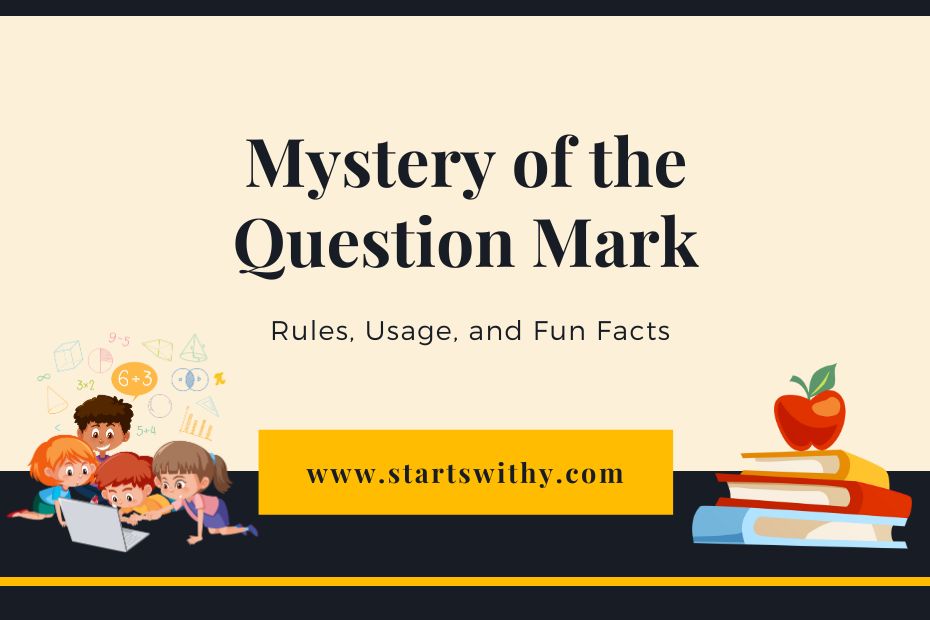Have you ever wondered about the significance of that small, curvy punctuation mark at the end of a sentence? The question mark, often referred to as the “interrogation point,” plays a crucial role in our written communication. In this article, I’ll delve into the world of question marks, exploring their usage, rules, and the impact they have on our sentences.
When it comes to using a question mark, there are certain guidelines to follow. It’s not just about indicating a question; there are indirect questions, commands, and even rhetorical questions that require different punctuation. Understanding when and how to use a question mark correctly can enhance the clarity and effectiveness of your writing. So, let’s explore the various scenarios where a question mark comes into play and unravel the mysteries behind this seemingly simple punctuation mark.
Question marks often go hand in hand with quotation marks and parentheses. Knowing where to place the question mark in relation to these punctuation marks can be a bit tricky. But fear not, I’ll provide you with clear guidelines to ensure that your question marks are in the right place, whether they are part of the quoted text or the surrounding sentence. So, let’s dive into the intricate relationship between question marks and quotation marks, as well as question marks and parentheses.
What is a Question Mark?
A question mark is a punctuation mark that is used to end interrogative sentences or questions. It is represented by a symbol “?” and placed at the end of a sentence to indicate that it is a direct question. The question mark is one of the main three end marks for sentences, along with the period and the exclamation point.
Definition
The question mark serves as a visual cue to readers that a sentence should be read as an inquiry or a question. It represents something unknown, unknowable, uncertain, or doubtful. It is used when seeking information, clarification, or confirmation from someone. In writing and printing, the question mark is placed at the conclusion of a sentence to indicate that it is a direct question.
Purpose
The purpose of the question mark is to clearly indicate to readers that a sentence requires a response or an answer. It signals that the sentence is asking for information or seeking clarification. The placement of the question mark depends on the structure of the sentence and should be used to accurately convey the intended meaning.
Usage
Question marks are used in a variety of ways in written communication. Here are a few key points to keep in mind:
- Question marks are used at the end of direct questions or interrogative sentences.
- They are also used for indirect questions, rhetorical questions, and commands that are phrased as questions.
- Question marks should be placed before a closing bracket or quotation mark if the question is part of the text in the brackets or quotation marks. They should be placed after the closing bracket or quotation mark if the question is part of the surrounding text.
Remember, using question marks accurately and appropriately helps readers understand the intended meaning of your sentences and ensures effective communication.
The History of the Question Mark
Origins
The origins of the question mark are shrouded in mystery and speculation. One theory suggests that it may have originated from the ancient Egyptians, who were known for their worship of cats. They may have observed the curious shape of a cat’s tail and incorporated that shape into the punctuation mark. Another theory links the question mark to the Latin word “quaestio,” meaning “question.” Scholars in the Middle Ages would write “quaestio” at the end of a sentence to indicate that it was a question, which eventually morphed into the modern question mark.
Evolution
The question mark made its first appearance in Latin manuscripts around the eighth or ninth century, possibly with the works of Alcuin, an English scholar and poet. Alcuin, who joined the court of Charlemagne in 781, created the “punctus interrogativus” or the point of interrogation. This symbol resembled a tilde or lightning flash with a rising tone of voice, representing the intonation used when asking a question. The question mark was not introduced to the English language until 1587 with the publication of Sir Philip Sidney’s “Arcadia,” where it appeared nearly 140 times.
Variations
Over time, variations of the question mark have emerged. The traditional question mark (?) remains the most widely recognized and used form. However, in some languages, such as Spanish, there is an upside-down question mark (¿) that is used at the beginning of a sentence to indicate a question. In informal online communication, the addition of multiple question marks (???) is often used to convey emphasis or incredulity.
The question mark has evolved from its ancient origins to become an integral part of written communication. Its history is fascinating, and its usage continues to play a crucial role in sentence structure and conveying meaning. By understanding the origins, evolution, and variations of the question mark, we can better appreciate its significance in effective communication.
Punctuation Rules for Question Marks
When it comes to using question marks in written communication, there are specific rules to follow to ensure clear and effective writing. In this section, I will discuss the key punctuation rules for question marks, including their placement, capitalization, and punctuating multiple questions.
Placement
The placement of question marks depends on the structure of the sentence. Here are the general guidelines:
- For straightforward questions that require a direct response, the question mark goes at the very end of the sentence. For example, “Where are you going?”
- If the question mark applies to the sentence as a whole, rather than to a specific phrase or word, it should be placed at the very end. This is true even when a quotation contains a question. For example, “Did he ask, ‘Are you coming?'”
- If a question mark applies to both a quoted phrase and the rest of the sentence, use only one question mark. For example, “Did he say, ‘Where are you going?'”
Capitalization
The capitalization of words following a question mark depends on the context:
- When a question comes at the end of a statement and is separated by a comma, the word following the comma is usually not capitalized. For example, “He wondered if she was telling the truth, but he wasn’t sure.”
- Capitalization of the question after the comma is used for extreme emphasis, but it is rarely recommended. For example, “Was he really doing the best he could? That was the question.”
- When a sentence begins with a question, the word following the question mark is not capitalized. For example, “Are you ready for the challenge? Let’s get started!”
Punctuating Multiple Questions
When writing a series of questions, each question should be punctuated with a question mark, even if the items are not complete sentences. Capitalization of the question items is optional, so be consistent with your chosen style. For example:
- “What is your favorite color? How old are you? Have you ever been to Paris?”
By following these punctuation rules for question marks, you can ensure clear and effective communication. Remember to consider the structure of your sentence, the capitalization of words following the question mark, and how to punctuate multiple questions. With these guidelines in mind, your writing will always convey your intended meaning.
Common Mistakes with Question Marks
Overusing or Underusing
One common mistake when it comes to question marks is overusing or underusing them. It’s important to use question marks appropriately to achieve clear and effective communication. Using too many question marks can make your writing seem overly dramatic or unprofessional, especially in formal or professional settings. On the other hand, not using question marks when they are necessary can lead to confusion and misunderstanding.
To avoid overusing question marks, it’s essential to consider the context and tone of your writing. Ask yourself if a question mark is truly needed to convey your message or if a different punctuation mark, such as a period, would be more appropriate. Remember that question marks are primarily used to end interrogative sentences or direct questions. If your sentence is not a question, it’s best to use a different punctuation mark.
Incorrect Placement
Another common mistake is incorrect placement of question marks. The placement of a question mark depends on the structure of the sentence. It should always come at the end of the sentence, directly after the question being asked. However, some writers make the mistake of placing a question mark in the wrong location, either before or in the middle of the sentence.
To avoid incorrect placement, carefully review your sentence structure and ensure that the question mark is placed at the appropriate location. Remember that question marks should not be used in commands or instructions, as they are not framed as questions. Additionally, when reporting previously asked questions in indirect speech, a question mark should not be used.
Confusion with Other Punctuation Marks
Question marks can sometimes be confused with other punctuation marks, leading to incorrect usage. For example, there can be confusion between question marks and exclamation marks in rhetorical questions. Depending on the context, a rhetorical question can end in either a question mark or an exclamation mark. However, it’s important to understand that the use of an exclamation mark adds emphasis and can make a rhetorical question sound more blunt.
To avoid confusion, it’s important to understand the specific rules and guidelines for using different punctuation marks. Familiarize yourself with the rules regarding question marks, exclamation marks, periods, and other punctuation marks to ensure proper usage in your writing.
Remember, by avoiding overusing or underusing question marks, using correct placement, and understanding the differences between question marks and other punctuation marks, you can enhance the clarity and effectiveness of your written communication.
Fun Facts about Question Marks
Trivia
Did you know that the question mark has a fascinating history? It is believed to have been introduced by Alcuin of York, an English scholar and poet, in the 9th century. Alcuin, who was invited to join the court of Charlemagne, created the “punctus interrogativus” or “point of interrogation,” a symbol resembling a tilde or lightning flash. This symbol represented the rising tone of voice used when asking a question.
Symbolism
The question mark also holds symbolic meaning. In literature and art, it is often used to represent doubt, uncertainty, and mystery. It can add a layer of intrigue and suspense to a story, leaving readers pondering the unanswered questions. This punctuation mark is a powerful tool for engaging the audience and keeping them invested in the narrative.
Cultural Significance
The question mark has made its way into various cultural expressions. In the Southern United States, for example, the shape of a buzzard soaring in the sky is often likened to a question mark. This metaphorical comparison adds a touch of whimsy to the description of the bird and demonstrates the creative ways in which the question mark can be incorporated into language.
These examples highlight some interesting aspects of the question mark’s trivia, symbolism, and cultural significance. It’s fascinating to see how this simple punctuation mark has made its mark on history, literature, and everyday language.
Conclusion
In this article, I have explored the significance of question marks in written communication and provided guidelines for their usage. By highlighting common mistakes and addressing incorrect placement, I have emphasized the importance of using question marks appropriately for clear and effective communication. It is crucial to carefully review sentence structure and understand the specific rules for using different punctuation marks to avoid confusion.
Additionally, I have delved into the fun facts about question marks, including their history, symbolism, and cultural significance. From their introduction by Alcuin of York in the 9th century to their representation of doubt and mystery in literature and art, question marks have a rich and fascinating background. Furthermore, their metaphorical comparison to a soaring buzzard in the Southern United States adds to their cultural significance.
By understanding the proper usage of question marks and appreciating their trivia and symbolism, we can enhance our written communication and engage readers effectively. So next time you encounter a question, remember to use the question mark wisely and make your words soar with clarity and impact.



